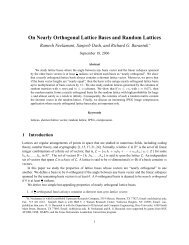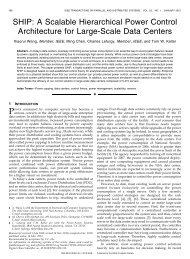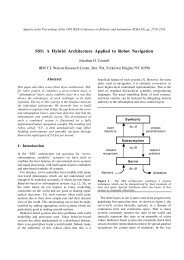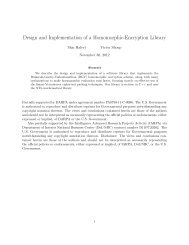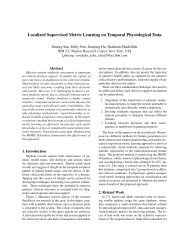Ownership You Can Count On: A Hybrid Approach - Researcher - IBM
Ownership You Can Count On: A Hybrid Approach - Researcher - IBM
Ownership You Can Count On: A Hybrid Approach - Researcher - IBM
Create successful ePaper yourself
Turn your PDF publications into a flip-book with our unique Google optimized e-Paper software.
value to a destination type. Explicit type conversions are<br />
performed by the type cast operator and by a small number of<br />
other language constructs.<br />
Every implicit conversion in Gel takes place in one of the<br />
following conversion contexts:<br />
• Assignment context: in an assignment V = E, when<br />
implicitly converting from the type of E to the type of V<br />
• Argument conversion context: in a method call, when<br />
implicitly converting a method argument to its<br />
corresponding parameter type<br />
• Return context: when converting the expression in a return<br />
statement to the method's return type<br />
• Other context: used for a small number of additional<br />
conversions<br />
We now present Gel's implicit and explicit conversion rules.<br />
(We omit rules relating to conversions between value types, such<br />
as between int and char; these rules are detailed in the Gel<br />
reference manual and are similar to value conversion rules in C#.)<br />
2.9.1 Implicit conversions<br />
Every type T is implicitly convertible to itself.<br />
If a type T is derived from a type U, then T is implicitly<br />
convertible to U.<br />
The null type is implicitly convertible to any reference type or<br />
owning type.<br />
T ^ is implicitly convertible to U ^ if T is implicitly<br />
convertible to U.<br />
In an argument conversion or local assignment context, T ^ is<br />
implicitly convertible to U if T is implicitly convertible to U, and<br />
either<br />
• the conversion is in an argument conversion context, or<br />
• the conversion is in an assignment context, and the source<br />
expression is classified as a variable.<br />
Any value type is implicitly convertible to object ^. In an<br />
argument conversion context, any value type is also implicitly<br />
convertible to object. These conversions are boxing conversions.<br />
In a compiled Gel program, a boxing conversion allocates a boxed<br />
object instance.<br />
string is implicitly convertible to object ^ and to<br />
object .<br />
2.9.2 Explicit conversions<br />
If T is implicitly convertible to U, then T is explicitly<br />
convertible to U.<br />
If type T is derived from a type U, then U is explicitly<br />
convertible to T. This conversion will fail if the source value is not<br />
an instance of T.<br />
T ^ is explicitly convertible to U ^ if T is explicitly convertible<br />
to U.<br />
object and object ^ are explicitly convertible to any<br />
value type T; this is an unboxing conversion. This conversion will<br />
fail if the source value is not actually an instance of T.<br />
object and object ^ are explicitly convertible to<br />
string. This conversion will fail if the source value is not<br />
actually a string.<br />
2.9.3 Discussion<br />
Gel never allows a type conversion to a non-owning to an<br />
owning pointer type. A conversion from an owning to a nonowning<br />
pointer is allowed only in certain contexts as per the rules<br />
above; when such a conversion occurs, at run time the source<br />
pointer retains ownership and a new non-owning pointer is<br />
created. The conversion rules disallow conversions which would<br />
inevitably lead to object destruction errors at run time. As an<br />
example, consider the following method:<br />
Foo Fun() {<br />
return new Foo();<br />
}<br />
The type conversion from Foo ^ to Foo occurs in a return<br />
context, and is hence disallowed. Gel could theoretically allow<br />
this type conversion and generate code for the method. Then at<br />
method exit the newly allocated Foo object would be destroyed<br />
(since it is owned by a temporary owning pointer, and ownership<br />
hasn't transferred elsewhere). But the destroyed object's nonowning<br />
pointer count would be 1, representing the non-owning<br />
pointer returned from the method, and so the object destruction<br />
would yield a run-time error.<br />
2.10 Erasure<br />
Note that Gel adds only two syntactic elements to C#: the type<br />
constructor ^ and the operator take. Suppose that we apply the<br />
following erasure transformation to a Gel program P:<br />
• We remove every instance of the ^ type constructor: we<br />
replace T ^ with T everywhere.<br />
• For each instance take E of the take operator, let T ^ be<br />
the compile-time type of E. Then we replace take E with<br />
the function call Take(ref E), where Take is defined<br />
as follows:<br />
T Take(ref T p) {<br />
T v = p;<br />
p = null;<br />
return v;<br />
}<br />
(Informally, this is a function which works like the take<br />
operator but acts on a non-owning type).<br />
Then the resulting program P' is a valid C# program. If P<br />
terminates without error, then P' will also terminate without error<br />
and will yield the same value as P.<br />
Note that the converse is not true: it is possible that P' may<br />
terminate without error, but that P will yield a run-time error. To<br />
see this, consider the following Gel function:<br />
int Fun() {<br />
Foo ^f = new Foo();<br />
Foo g = f;<br />
f = null;<br />
return 4;<br />
}<br />
This function will yield a run-time error in Gel, since at the<br />
moment f is destroyed there is still a non-owning pointer g to the<br />
same object. But if we apply the erasure transformation to this<br />
function, then the resulting C# function will execute without error.<br />
3. PROGRAMMING IN GEL<br />
We have described the Gel language. We must now address<br />
two questions: how easy is it to use Gel's type system for writing<br />
real programs, and how well will Gel programs perform? We<br />
discuss usability in this section and performance in following<br />
sections.




